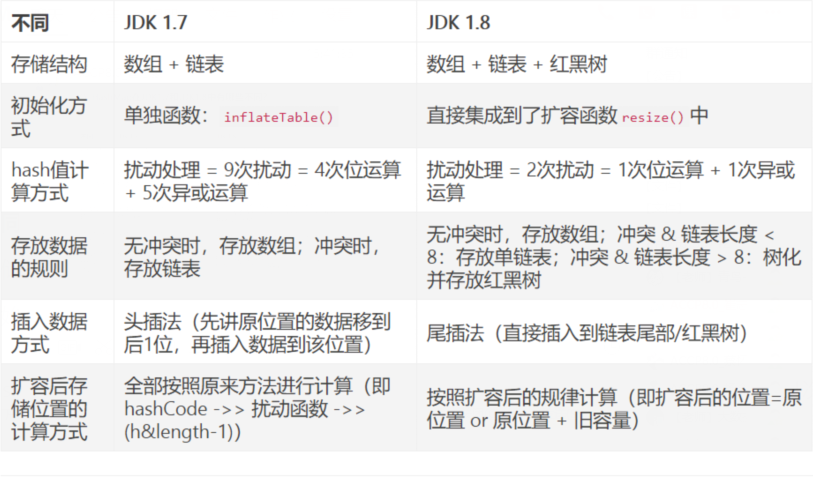HashMap底层源码剖析
1、HashMap底层用到的数据结构
数组+单向链表+红黑树
数组:数组每一项都是一个链表,其实就是数组和链表的结合体
单向链表:当法神hash碰撞时,首先会找到数组对应位置,然后1.8采用尾插入法(1.7采用头插入法),形成一个单项链表结构
红黑树:当数组中每项的链表长度大于8时,会转换为红黑树
2、什么是hash碰撞?解决方案?
hash碰撞:不同的key可能会产生相同的hash值;
方案:链表发,再哈希法;
hashMap中采用链表发,在ConcurrentHashMap中采用哈希法;
3、红黑树与二叉树比较
二叉查找树在特殊情况下也会变成线性结构,和原来链表有共同的问题,节点太深,查找性能慢;
红黑树相比二叉树,在检索的时候效率其实差不多,都是通过平衡来二分查找。但对于插入删除等操效率提高很多。红黑树不像二叉树一样追求绝对的平衡,它允许局部很少的不完全平衡,这样对于效率影响不大,但省去了很多没有必要的调平衡操作,二叉树调平衡有时候代价较大,所以二叉树的效率不如红黑树;
4、为什么采用红黑树
在平常我们用HashMap的时候,HashMap里面存储的key是具有良好的hash算法的key(比如String、Integer等包装类),冲突几率自然微乎其微,此时链表几乎不会转化为红黑树,但是当key为我们自定义的对象时,我们可能采用了不好的hash算法,使HashMap中key的冲突率极高,但是这时HashMap为了保证高速的查找效率,就引入了红黑树来优化查询了。
5、为什么树化的临界值为8?
通过源码我们得知HashMap源码作者通过泊松分布算出,当桶中结点个数为8时,出现的几率是亿分之6的,因此常见的情况是桶中个数小于8的情况,此时链表的查询性能和红黑树相差不多,因为转化为树还需要时间和空间,所以此时没有转化成树的必要。
当数据较少的时候,采用链表要比红黑树效率高,因为平衡二叉树保持平衡需要耗费资源,那么前期数据较少时采用链表,当链表中的数据长度大于8时,就将链表转换成红黑树,可以加快数据的插叙速度,官方测试8为性能最优。
6、put()底层源码分析
public V put(K key, V value) { return putVal(hash(key), key, value, false, true); }
/** * Implements Map.put and related methods * * @param hash hash for key * @param key the key * @param value the value to put * @param onlyIfAbsent if true, don't change existing value * @param evict if false, the table is in creation mode. * @return previous value, or null if none */ final V putVal(int hash, K key, V value, boolean onlyIfAbsent, boolean evict) { Node<K,V>[] tab; Node<K,V> p; int n, i; //判断如果table为空,或者还没有元素时,就进行扩容 if ((tab = table) == null || (n = tab.length) == 0) //扩容后将扩容大小交给n n = (tab = resize()).length; //判断获取当前数组位置是否存在数据,如果为空则直接插入,如果不为空,就进行下面的判断 //(n-1) & hash才是真正的hash值,也就是存储在table位置的index; if ((p = tab[i = (n - 1) & hash]) == null) tab[i] = newNode(hash, key, value, null); else { //到这里,就说明发生碰撞了,就要开始处理碰撞问题 Node<K,V> e; K k; //判断hash值和key值是否相同,如果相同则需要value覆盖 if (p.hash == hash && ((k = p.key) == key || (key != null && key.equals(k)))) e = p; //判断当前数组中存放的节点是否是树节点 else if (p instanceof TreeNode) e = ((TreeNode<K,V>)p).putTreeVal(this, tab, hash, key, value); else { //到这一步,说明首节点为链表类型 //循环遍历链表 for (int binCount = 0; ; ++binCount) { //判断当前数组该位置的值的下一个元素是佛为空,如果为空则追加到当前元素后边 if ((e = p.next) == null) { p.next = newNode(hash, key, value, null); //添加完毕后判断当前链表节点有多少个,如果节点大于等于8则转换为红黑树 if (binCount >= TREEIFY_THRESHOLD - 1) // -1 for 1st //treeifyBin判断当前数组是否为空,或者长度是否小于64,如果为空或者小于64,则扩容 treeifyBin(tab, hash); break; } //再次进行key的重复判断 if (e.hash == hash && ((k = e.key) == key || (key != null && key.equals(k)))) break; p = e; } } //表明,记录到具有相同元素的节点 if (e != null) { // existing mapping for key V oldValue = e.value; if (!onlyIfAbsent || oldValue == null) e.value = value; //这个是空函数,可以有用户根据需要覆盖 afterNodeAccess(e); return oldValue; } } ++modCount; //判断当前数组元素的个数和阈值进行比较,如果数量大于阈值则需要扩容 if (++size > threshold) //默认情况下,第一次添加数据的时候,先会进行一次扩容后再添加数据,后续都是先添加数据在进行扩容 resize(); //这个是空函数,可以有用户根据需要覆盖 afterNodeInsertion(evict); return null; }
在上述的方法中,设计三种情况:
第一种情况,数组索引位置没有键值对,处理方式就是直接把待添加键值对封装成Node添加到索引位置即可;
第二种情况,如果数组索引位置有键值对,而且封装的TreeNode节点,处理方式是调用红黑树的插入方法,把带添加键值对添加到红黑树中;
第三种情况,同样数组索引位置有键值对,但是封装的是Node节点,处理方法就比较复杂,首先把待添加键值对封装成Node节点添加到链表尾部,然后判断当前链表长度,如果达到阈值,就判断是扩容还是转换为红黑树;

7、get()底层源码分析
public V get(Object key) { Node<K,V> e; return (e = getNode(hash(key), key)) == null ? null : e.value; } /** * Implements Map.get and related methods * * @param hash hash for key * @param key the key * @return the node, or null if none */ final Node<K,V> getNode(int hash, Object key) { Node<K,V>[] tab; Node<K,V> first, e; int n; K k; //判断数组以及数组对应位置数组元素是否为空 if ((tab = table) != null && (n = tab.length) > 0 && (first = tab[(n - 1) & hash]) != null) { /用get传递过来的key值对应位置第一个元素进行比较,如果相等就直接返回,如果不相等则进行查找 if (first.hash == hash && // always check first node ((k = first.key) == key || (key != null && key.equals(k)))) return first; //判断第一个元素的下一个元素是否为空 if ((e = first.next) != null) { //如果不为空就判断当前节点是否为树节点 if (first instanceof TreeNode) //如果是树节点,直接通过getTreeNode拿到该节点返回 return ((TreeNode<K,V>)first).getTreeNode(hash, key); do { //否则循环意义对比 if (e.hash == hash && ((k = e.key) == key || (key != null && key.equals(k)))) return e; } while ((e = e.next) != null); } } return null; }
8、扩容机制分析
在HashMap中,桶数组的长度均是2的幂,阈值大小为桶数组长度与负载因子的乘积。当HashMap中的键值对数量超过阈值时,就进行扩容;
扩容之后,要重新计算键值对的位置,并把它们移到合适的位置上去;
/** * Initializes or doubles table size. If null, allocates in * accord with initial capacity target held in field threshold. * Otherwise, because we are using power-of-two expansion, the * elements from each bin must either stay at same index, or move * with a power of two offset in the new table. * * @return the table */ final Node<K,V>[] resize() { Node<K,V>[] oldTab = table; int oldCap = (oldTab == null) ? 0 : oldTab.length; int oldThr = threshold; int newCap, newThr = 0; //如果table不为空,表明已经初始化过了 if (oldCap > 0) { //当table容量超过容量最大值,则不再扩容 if (oldCap >= MAXIMUM_CAPACITY) { threshold = Integer.MAX_VALUE; return oldTab; } //按旧容量或阈值的2倍计算新容量和阈值大小 else if ((newCap = oldCap << 1) < MAXIMUM_CAPACITY && oldCap >= DEFAULT_INITIAL_CAPACITY) newThr = oldThr << 1; // double threshold } else if (oldThr > 0) // initial capacity was placed in threshold //初始化时,将threshold的值赋值给newCap; //HashMap使用threshold变量暂时保存initialCapacity参数的值 newCap = oldThr; else { // zero initial threshold signifies using defaults //调用无参构造方法时,桶数组容量为默认容量;阈值为默认容量与默认负载因子 newCap = DEFAULT_INITIAL_CAPACITY; newThr = (int)(DEFAULT_LOAD_FACTOR * DEFAULT_INITIAL_CAPACITY); } //newThr为0时,按阈值计算公式进行计算 if (newThr == 0) { float ft = (float)newCap * loadFactor; newThr = (newCap < MAXIMUM_CAPACITY && ft < (float)MAXIMUM_CAPACITY ? (int)ft : Integer.MAX_VALUE); } threshold = newThr; @SuppressWarnings({"rawtypes","unchecked"}) //创建新的桶数组,桶数组的初始化也是这里完成的 Node<K,V>[] newTab = (Node<K,V>[])new Node[newCap]; table = newTab; if (oldTab != null) { //如果旧的桶数组不为空,则遍历桶数组,并将键值对映射到新的桶数组中 for (int j = 0; j < oldCap; ++j) { Node<K,V> e; if ((e = oldTab[j]) != null) { oldTab[j] = null; if (e.next == null) newTab[e.hash & (newCap - 1)] = e; else if (e instanceof TreeNode) //重新映射时,需要对红黑树进行拆分 ((TreeNode<K,V>)e).split(this, newTab, j, oldCap); else { // preserve order Node<K,V> loHead = null, loTail = null; Node<K,V> hiHead = null, hiTail = null; Node<K,V> next; //遍历链表,并将链表节点按原顺序进行分组 do { next = e.next; if ((e.hash & oldCap) == 0) { if (loTail == null) loHead = e; else loTail.next = e; loTail = e; } else { if (hiTail == null) hiHead = e; else hiTail.next = e; hiTail = e; } } while ((e = next) != null); //将分组后的链表映射到新桶中 if (loTail != null) { loTail.next = null; newTab[j] = loHead; } if (hiTail != null) { hiTail.next = null; newTab[j + oldCap] = hiHead; } } } } } return newTab; }
扩容的源码总共做了三件事:
①计算新桶数组的容量newCap和新阈值newThr
②根据计算出的newCap创建新的桶数组,桶数组table也是这里进行初始化的
③将键值对节点重新映射到新桶数组中,如果节点是TreeNode类型,则需要拆分红黑树;如果是普通节点,则节点按原顺序进行分组
9、HashMap在JDK1.7与JDK1.8的不同





 浙公网安备 33010602011771号
浙公网安备 33010602011771号